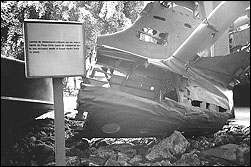 |
The wreckage of a CIA
bomber is now displayed
at Havana's Museum
of the Revolution
|
5: The Brigade Hits the Beach
When the exile troops landed at the Bay of Pigs in Cuba, the Fidel Castro took personal command of the effort to repel the invaders. He quickly mobilized military and militia units, and instructed his few remaining fighter planes to bomb and strafe the invasion force (several of Cuba's aircraft had been destroyed in air strikes preceding the invasion).
The long-planned covert action to oust Castro met a surprisingly speedy defeat. Cuban air force pilots managed to destroy ships just off the beach that were to supply the invaders with needed ammunition and communication equipment. Cut off from this lifeline and running short on bullets, the exile brigade struggled in vain for a few days before almost all of its members were killed or captured. When the shooting was over, 114 members of the brigade were dead and 1,189 had become Castro's prisoners.
Cuba's revolutionary army and militia had thwarted the invaders before they were able to establish a solid foothold on the island. In Washington, the White House went into a brief period of shock. President Kennedy recovered quickly, however, and made a statement acknowledging U.S. support for the invaders. Days later he said that U.S. efforts to oust Castro with the Bay of Pigs invasion had been restrained, and that future U.S. action against the Cuban government might be more severe.
The covert invasion of Cuba had been a foreign policy disaster, what one historian called "the perfect failure." The events at the Bay of Pigs resulted in embarrassment for the Kennedy administration and provided Castro with a major issue with which to rally the people of Cuba. Though three and a half decades have passed since the invasion, the memory of the Bay of Pigs continues to influence the present-day tensions between the U.S. and Cuba.
(c) Copyright 1996 ParaScope, Inc.

